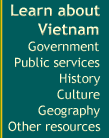Vietnamese land comprises 7 groups: salted soil, alum, alluvium, muddy
land, peat, grey exhausted soil; most of the land belong to different
kinds of alluvium, grey soil and alum. On the whole, Vietnamese soil has
thick strata and high fertility, it provides very favorable conditions for
the development of agriculture and forestry
.
The monsoon tropical climate, sunshine and rain have given
Vietnam and abundant and diversified vegetation. The Vietnamese territory
lies at the convergence of atmospheric currents and has received a great
number of seeds from the north, west and south, that is why the forests
hav many strains and species of vegetation. Vietnam has over 800 wood
species many of which are precious due to their hardness, solidity,
beautiful grains and colors. The famous wood species comprise iron wood,
oak, teak; thitka on limestone mountains; wood with beautiful grains such
as mahogany, calamander, barian kingwood, aqilaria, species of peumou,
yellow wood pedo-carpus fleuryi, comphor-trees also abound. The virgin
forests have a reserve of wood of over 300 cubic meters per hectars
.
The fauna is as abundant and diversified as the flora. In
Vietnam there exist a variety of ancient tropical fauna and about 200
species of animals, 800 species of birds, 100 species of amphibians and
over 150 species of reptiles. 1,000 species live in the seas and rivers
and 200 species live in fresh water
Dense forests, limestone mountain forests, multi-canopied
forests constitute tha habitat of different species of monkeys, langurs,
gibbons, wild cats and squirrels. Vietnamese forests have typical monkey
species such as white-headd langurs, rhinopithecus, black mokeys.
Likewise, there are valuable species of birds such as pheasants,
pheinardia ocellata. There are many species of reptiles: boas, iguanas,
snakes, chameleons, centipedes. The high mountains in the north have many
furred wild animals like selenartos, small bears, big black squirrels,
foxes, otters, civet cats
.
Aminals living in fresh waters comprise 250 fish species;
brackish water and caostal areas are the habitat of 1,000 species of
fishes, 300 species of crabs, 40 species of shrimps and lobsters, 300
species of oysters and sea snails. Besides, there are clams, seaslugs, sea
turtles, pearl oysters; 300 species of seaweeds; in particular ther are
salanganes on rocky mountains on islands
.
Though the Vietnamese fauna is rich, varied and comprises rare
species of high value, not all of them are available in large quantities
.
Vietnam has great potentialities for mineral ores, underground
resources, and riches under the sea-bed. It ranks among the countries
having average reserves of oil and gas which are gradually being
exploited. All kind of mineral resources exist, some with large reserves:
coal, iron, bauxite, etc. Small mines arre scattered all over the country.
The natural conditions of Vietnam also present an unfavorable
aspect. A particular feature of the monsoon climate is its uncertainty.
Cold comes early in some years, late in others. Some years are marked by
heavy rains and big floods, and others by prolonged periods of drought
.
The humid maritime climate facilitates the generation of fungi
and insects while accelerating the corrosion of machinery and equipment.
Steep slopes and existence of many rivers and streams creates difficulties
for the building of the communication network. Land erosion is a danger to
be checked in the first place. The diversity of flora and fauna and their
existence is in scattered state and small quantity make it difficult to
organize breeding
.











